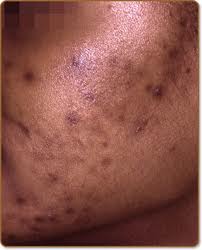 The pursuit of clear, even, healthy skin is one with which many of us are familiar. When it comes to black skin care, achieving an even skin tone, free of dark spots and hyperpigmentation, can be additionally problematic because our dark skin is more likely to be oily and therefore, more acne-prone. The higher melanin content in our skin is a blessing (our skin ages more slowly than that of lighter-skinned races), but it also makes us more susceptible to keloid scarring and hyperpigmentation.
The pursuit of clear, even, healthy skin is one with which many of us are familiar. When it comes to black skin care, achieving an even skin tone, free of dark spots and hyperpigmentation, can be additionally problematic because our dark skin is more likely to be oily and therefore, more acne-prone. The higher melanin content in our skin is a blessing (our skin ages more slowly than that of lighter-skinned races), but it also makes us more susceptible to keloid scarring and hyperpigmentation.
Marketing terminology for skin toning products can be confusing (and a political hot topic in the black community): does your product declare itself to be for skin lightening, skin bleaching or skin toning? Ultimately, they all do the same thing and contain many of the same ingredients.
Here are some of the best ways to approach the issue of clearing uneven African-American skin:
Do your research, but first – visit a Medical Doctor/Dermatologist
If you can do it, this is the best first step in your skin toning action plan. Your doctor may be able to establish specifically what is causing your hyperpigmentation. A common cause of dark skin patches in African-Americans is uncontrolled hypertension (high blood pressure) and if treated effectively, you may have no need for any topical skin tone creams/serums.
If your uneven skin tone is caused by environmental factors (sun, etc.), acne or ageing, your dermatologist will be able to advise you as to the safest and most effective treatments for your problem. If you are pregnant, avoid the use of any skin tone creams/serums.
Avoid harsh cleansers and scrubs
Sometimes, facial cleansers and scrubs marketed to acne sufferers contain alcohol which can be both stripping and drying, thus causing the skin to produce more oil, leading in turn, to more acne outbreaks and dark marks. Use the gentlest facial cleansers you can find – and skip any scrubs that contain ground nuts. Look for kojic acid, salicylic acid, lactic acid and glycolic acid in cleansers, and concentrate use on affected areas only – avoid the eyes. Dark circles around the eyes are notoriously difficult to remove safely. Often, the circles are hereditary, but can sometimes be indicative of serious health issues. Ideally, consult a physician before attempting to treat dark eye circles.
Exfoliate with care and don’t skip the toner!
A good, but gentle exfoliation, twice a week, can be very helpful in fading dark patches. By sloughing off dead skin to reveal fresher, healthier, smoother skin below, you may also see increased efficacy of your skin toning products. Try a gentle, non-gritty exfoliator or a mild facial peel. Enzymatic peels that contain fruit acids such as pineapple or papaya are reported to be the most effective.
The debate about the necessity for toner in a skin care regime shows no signs of abating, but I recommend toner as an important step in enhancing the complexion. The best toners also contain fruit acids or essential oils. If you have sensitive skin, use toner every other day.
If acne is the problem – treat it first and foremost
Get your acne under control before attempting to fade hyperpigmentation. If you mix too many products, you may be unwittingly sabotaging your recovery/results.
Avoid hydroquinone, where possible – and never use products that contain mercury or steroids
Many skin tone creams contain hydroquinone, an effective skin lightener. If bought over the counter, formulations should contain no more than 2% hydroquinone. Over-use/misuse of hydroquinone can lead to a permanent blue/blackening of the skin (ochronosis).
Medical/pharmaceutical grade hydroquinone serums and creams can contain up to 4% hydroquinone and are safe provided they are used as directed by your doctor for a short period of time.
Caution: Hydroquinone is being pulled from a lot of markets because of it’s known association to cancer and internal organ diseases.
Skin creams that contain mercury are banned in the US, but may still find their way on to the shelves of smaller stores. Never use these formulations. Mercury is poisonous and its use can lead to kidney and neurological disorders, and birth defects.
Opt for safer, natural skin lighteners/toners
Look for products that contain alpha arbutin, bearberry extract, mulberry extract, Vitamin C, licorice extract, aloe vera gel and kojic acid. Some do-it-yourselfers have had positive results with homemade skin lighteners such as yogurt, lemon juice and turmeric.
Try these homemade formulations on hyperpigmented areas, daily; (proceed with caution if you have sensitive skin):
Make a paste from lemon juice, yogurt and oatmeal. Rub into the affected area(s) and leave on approximated 20 minutes. Rinse off with lukewarm water.
OR
Mix 2 tablespoons of orange juice with a pinch of turmeric. Apply to affected area(s), leave for 20 minutes. Rinse off with lukewarm water.
Protect your skin from the sun and apply a sunscreen
Skin that is being treated for hyperpigmentation is particularly sensitive to UVA/UVB rays, which can cause re-darkening. Apply an SPF of at least 30 over treated areas and limit sun exposure – especially between the hours of 10am and 2pm. Look for moisturizers and cosmetics (foundation) that have a built-in SPF should you find that traditional sunscreens irritate your sensitive/acne-prone skin.
Be patient – and fake it until you make it
It can take six to twelve weeks before you start to see a significant fading of dark marks. Cosmetics can help in the meantime. Try a good creamy concealer for small areas of discoloration. Larger patches can be more problematic to camouflage, but there are some excellent heavier cover-up foundations and concealers on the market for this purpose.
Keep a log or diary of your skin toning trials, and take pictures – you’d be surprised how it helps in tracking your progress, tweaking your regimen and it is invaluable when consulting with a skin specialist.
That’s it for this week. As always …
Dedicated To Your Beauty,
Juliette Samuel
Esthetician/Author/Publisher




 Facebook
Facebook Twitter
Twitter Delicious
Delicious Digg
Digg Myspace
Myspace StumbleUpon
StumbleUpon Youtube
Youtube